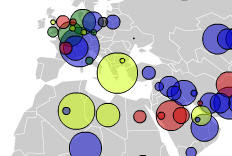Geography and Journalism
The session for news media at the EsriUC was easy to miss because it was on Sunday associated with the Business Summit. But it's importance is tied to how geospatial information and technology enters an era of mainstream adoption.
Two excellent presentations focused on not only how maps bring context to stories but when maps "serve as the central vehicle to create a narrative," as described by Roberto Suro, professor at the University of Southern California's Annenberg School for Communication and Journalism and Managing Director of the Annenberg Innovation Lab.
Suro asked, "How do we recover the sense of narrative in an era of data overload? How, as a content creator, do we reestablish the authority of a story teller." Suro discussed where maps and visualization can foster a different journalistic technique. "What do you have to have to make a map tell a story? You have to start with the centrality of place. The "where" is the focal point around which the other elements circle, said Suro.
He mentioned how the most common narrative structure is chronological and how there are a lot of stories that combine chronology with geography. But to make maps more central to the narrative involves a small change in perspective. "The basic mechanical function is different [which is the] geotagging elements of information … and telling a narrative completely through maps," he said.
Matt Waite, a professor at the University of Nebraska's College of Journalism and Mass Communications, and a Pulitzer Prize winner during his time at the St. Petersburg Times for his creation of PolitiFact.com, a fact-checking website that tracks what politicians are saying. Wait took today's publishers to task for using the same "byzantine" production model that's been in use for decades. "If we mess with this thing we are messing with the most foundational thing that we do ... Digital production is very flexible - publishers don't like to hear this," said Waite.
Waite said that, "We are creating a news database augmented by all sorts of data; there are subjects that we can connect to with a complete set of links. Rules can be broken."
He gave an example of how certain stories dealing with crime have certain structured data like addresses or historical crime information, that is, a geographic context. "You start to add these pieces of greater context and it becomes much more than a story; it is context; it is data. When you start to see news as part of a greater whole," said Waite.
Since, as a publisher of a geospatial magazine, we see the technology side of stories and often little about context. In our application articles we like maps to tell a story too. That's what we do as geographers. We tell a story. It may not be a news story like in newspapers or magazine, but maps communicate in a way that tabular information can not. And isn't that the story of GIS?
[Originally published at apb.directionsmag.com]
Two excellent presentations focused on not only how maps bring context to stories but when maps "serve as the central vehicle to create a narrative," as described by Roberto Suro, professor at the University of Southern California's Annenberg School for Communication and Journalism and Managing Director of the Annenberg Innovation Lab.
Suro asked, "How do we recover the sense of narrative in an era of data overload? How, as a content creator, do we reestablish the authority of a story teller." Suro discussed where maps and visualization can foster a different journalistic technique. "What do you have to have to make a map tell a story? You have to start with the centrality of place. The "where" is the focal point around which the other elements circle, said Suro.
He mentioned how the most common narrative structure is chronological and how there are a lot of stories that combine chronology with geography. But to make maps more central to the narrative involves a small change in perspective. "The basic mechanical function is different [which is the] geotagging elements of information … and telling a narrative completely through maps," he said.
Matt Waite, a professor at the University of Nebraska's College of Journalism and Mass Communications, and a Pulitzer Prize winner during his time at the St. Petersburg Times for his creation of PolitiFact.com, a fact-checking website that tracks what politicians are saying. Wait took today's publishers to task for using the same "byzantine" production model that's been in use for decades. "If we mess with this thing we are messing with the most foundational thing that we do ... Digital production is very flexible - publishers don't like to hear this," said Waite.
Waite said that, "We are creating a news database augmented by all sorts of data; there are subjects that we can connect to with a complete set of links. Rules can be broken."
He gave an example of how certain stories dealing with crime have certain structured data like addresses or historical crime information, that is, a geographic context. "You start to add these pieces of greater context and it becomes much more than a story; it is context; it is data. When you start to see news as part of a greater whole," said Waite.
Since, as a publisher of a geospatial magazine, we see the technology side of stories and often little about context. In our application articles we like maps to tell a story too. That's what we do as geographers. We tell a story. It may not be a news story like in newspapers or magazine, but maps communicate in a way that tabular information can not. And isn't that the story of GIS?
[Originally published at apb.directionsmag.com]

Comments